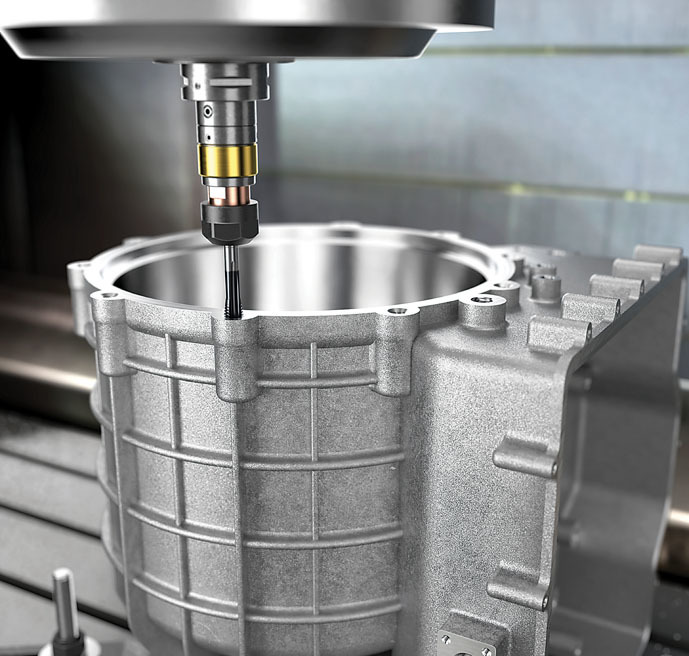Aluminum alloys are popular in numerous industries — from aerospace to automotive — because they offer a high strength-to-weight ratio, excellent thermal conductivity and corrosion resistance. Tapping threads in aluminum components, however, presents unique challenges. Because aluminum is relatively soft and “gummy,” it can lead to issues such as poor chip evacuation, built-up edge (BUE) and inconsistent thread finish. Understanding how to overcome these hurdles is key to producing reliable, high-quality threads.
Choose the Right Tap Geometry
One of the most critical decisions for tapping aluminum is the selection of a suitable tap geometry. Generally, spiral-fluted or straight-fluted taps can be used; the choice depends on the application and aluminum grade. Spiral-fluted taps are ideal for blind holes in softer materials because they facilitate better chip evacuation. They pull chips back out of the hole, helping avoid chip packing that leads to poor thread finishes or breakage.
Additionally, the tap’s rake angle and relief features should be designed for softer materials. A high rake angle can help reduce cutting forces and minimize burr formation. For form taps (also known as roll taps), the geometry is optimized to plastically deform the material instead of cutting it, eliminating the production of chips altogether. Form tapping in aluminum can deliver excellent thread strength, provided the specific aluminum grade is compatible with this method.

CoroTap® 400 is a high-speed, chip-free forming tap suitable for both through- and blind-holes in steel, stainless steel, aluminum, and HRSAs. Sandvik Coromat
Optimize Cutting Parameters
Aluminum’s gummy nature can cause material to adhere to the cutting edge, creating BUE. To mitigate this, running at higher surface speeds — without exceeding recommended limits — may help shear the material cleanly and reduce BUE formation. However, striking the right balance is essential. Excessive speed can overheat the tap, reduce tool life and degrade thread quality.
Equally important is the feed rate. Since tapping is a synchronized process, the feed must match the thread pitch. For form tapping, slightly different speeds and feed profiles might be employed, as the process depends on material flow rather than chip removal. Always refer to tooling guidelines and perform test cuts to fine-tune parameters for each aluminum alloy.
Proper Lubrication
Effective lubrication is paramount for tapping aluminum, as it reduces friction, prevents chip welding and flushes chips from the cutting zone. Water-soluble coolants, with adequate lubrication properties, typically perform well when tapping. In some high-speed production environments, minimum-quantity lubrication (MQL) systems provide a fine mist of oil that can also help lower friction and improve chip evacuation.
To reduce the likelihood of BUE, choose a coolant or lubricant specifically formulated for aluminum. Additives like sulfur or chlorine can enhance lubricity, but always confirm compatibility with both the workpiece material and any applicable environmental or safety regulations.

CoroTap™ 100's optimized grades ensure low friction at high speeds for precision threads, resulting in excellent thread quality. Sandvik Coromat
Ensure Rigid Setups
Maintaining rigid setups is essential for consistent tapping performance. Excessive vibration or axial runout can result in misaligned holes, broken taps and inconsistent thread geometry. Use high-quality toolholders designed for tapping — ideally with minimal runout and some float or compensation to accommodate any minor misalignment between the spindle and hole center.
Equally important is securing the workpiece to eliminate movement during tapping. For CNC machines, ensure the axis alignment is accurate and that tapping cycles (rigid or synchronous tapping) are well-suited for aluminum.
Consider Thread Milling
In applications where burrs, chips or close-tolerance threads pose challenges, thread milling can serve as an alternative to tapping. Thread milling uses a helical cutting motion and can reduce the risk of broken taps and minimize downtime. While tapping is still faster for many high-volume aluminum applications, thread milling offers more flexibility and can produce threads of various diameters with one tool. Depending on the complexity, material thickness and machine capabilities, weigh whether tapping or thread milling is the optimal solution.
By paying close attention to tap geometry, optimizing speeds and feeds, using proper lubrication, and ensuring rigid setups, manufacturers can significantly improve the consistency and quality of tapped holes in aluminum. Thorough planning and testing are essential, as each aluminum alloy can behave differently. With the right approach, tapping remains a cost-effective, high-productivity method for creating threads in these widely used and versatile materials.
Related Glossary Terms
- alloys
alloys
Substances having metallic properties and being composed of two or more chemical elements of which at least one is a metal.
- aluminum alloys
aluminum alloys
Aluminum containing specified quantities of alloying elements added to obtain the necessary mechanical and physical properties. Aluminum alloys are divided into two categories: wrought compositions and casting compositions. Some compositions may contain up to 10 alloying elements, but only one or two are the main alloying elements, such as copper, manganese, silicon, magnesium, zinc or tin.
- built-up edge ( BUE)
built-up edge ( BUE)
1. Permanently damaging a metal by heating to cause either incipient melting or intergranular oxidation. 2. In grinding, getting the workpiece hot enough to cause discoloration or to change the microstructure by tempering or hardening.
- built-up edge ( BUE)2
built-up edge ( BUE)
1. Permanently damaging a metal by heating to cause either incipient melting or intergranular oxidation. 2. In grinding, getting the workpiece hot enough to cause discoloration or to change the microstructure by tempering or hardening.
- burr
burr
Stringy portions of material formed on workpiece edges during machining. Often sharp. Can be removed with hand files, abrasive wheels or belts, wire wheels, abrasive-fiber brushes, waterjet equipment or other methods.
- computer numerical control ( CNC)
computer numerical control ( CNC)
Microprocessor-based controller dedicated to a machine tool that permits the creation or modification of parts. Programmed numerical control activates the machine’s servos and spindle drives and controls the various machining operations. See DNC, direct numerical control; NC, numerical control.
- coolant
coolant
Fluid that reduces temperature buildup at the tool/workpiece interface during machining. Normally takes the form of a liquid such as soluble or chemical mixtures (semisynthetic, synthetic) but can be pressurized air or other gas. Because of water’s ability to absorb great quantities of heat, it is widely used as a coolant and vehicle for various cutting compounds, with the water-to-compound ratio varying with the machining task. See cutting fluid; semisynthetic cutting fluid; soluble-oil cutting fluid; synthetic cutting fluid.
- corrosion resistance
corrosion resistance
Ability of an alloy or material to withstand rust and corrosion. These are properties fostered by nickel and chromium in alloys such as stainless steel.
- feed
feed
Rate of change of position of the tool as a whole, relative to the workpiece while cutting.
- gang cutting ( milling)
gang cutting ( milling)
Machining with several cutters mounted on a single arbor, generally for simultaneous cutting.
- lubricity
lubricity
Measure of the relative efficiency with which a cutting fluid or lubricant reduces friction between surfaces.
- milling
milling
Machining operation in which metal or other material is removed by applying power to a rotating cutter. In vertical milling, the cutting tool is mounted vertically on the spindle. In horizontal milling, the cutting tool is mounted horizontally, either directly on the spindle or on an arbor. Horizontal milling is further broken down into conventional milling, where the cutter rotates opposite the direction of feed, or “up” into the workpiece; and climb milling, where the cutter rotates in the direction of feed, or “down” into the workpiece. Milling operations include plane or surface milling, endmilling, facemilling, angle milling, form milling and profiling.
- minimum-quantity lubrication
minimum-quantity lubrication
Use of cutting fluids of only a minute amount—typically at a flow rate of 50 to 500 ml/hr.—which is about three to four orders of magnitude lower than the amount commonly used in flood cooling. The concept addresses the issues of environmental intrusiveness and occupational hazards associated with the airborne cutting fluid particles on factory shop floors. The minimization of cutting fluid also saves lubricant costs and the cleaning cycle time for workpieces, tooling and machines. Sometimes referred to as “near-dry lubrication” or “microlubrication.”
- pitch
pitch
1. On a saw blade, the number of teeth per inch. 2. In threading, the number of threads per inch.
- rake
rake
Angle of inclination between the face of the cutting tool and the workpiece. If the face of the tool lies in a plane through the axis of the workpiece, the tool is said to have a neutral, or zero, rake. If the inclination of the tool face makes the cutting edge more acute than when the rake angle is zero, the rake is positive. If the inclination of the tool face makes the cutting edge less acute or more blunt than when the rake angle is zero, the rake is negative.
- relief
relief
Space provided behind the cutting edges to prevent rubbing. Sometimes called primary relief. Secondary relief provides additional space behind primary relief. Relief on end teeth is axial relief; relief on side teeth is peripheral relief.
- tap
tap
Cylindrical tool that cuts internal threads and has flutes to remove chips and carry tapping fluid to the point of cut. Normally used on a drill press or tapping machine but also may be operated manually. See tapping.
- tapping
tapping
Machining operation in which a tap, with teeth on its periphery, cuts internal threads in a predrilled hole having a smaller diameter than the tap diameter. Threads are formed by a combined rotary and axial-relative motion between tap and workpiece. See tap.

